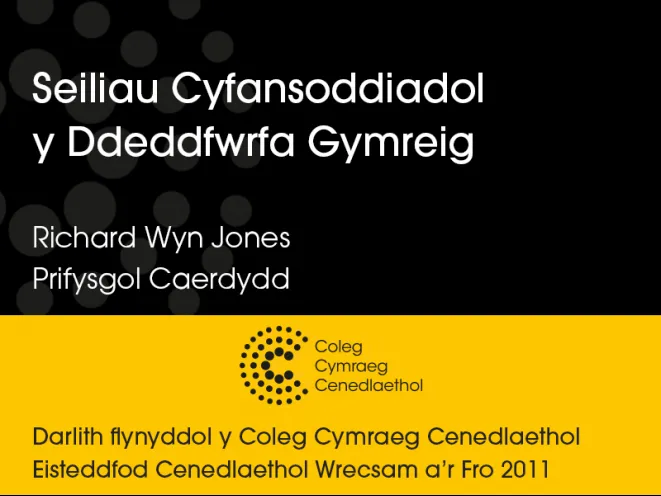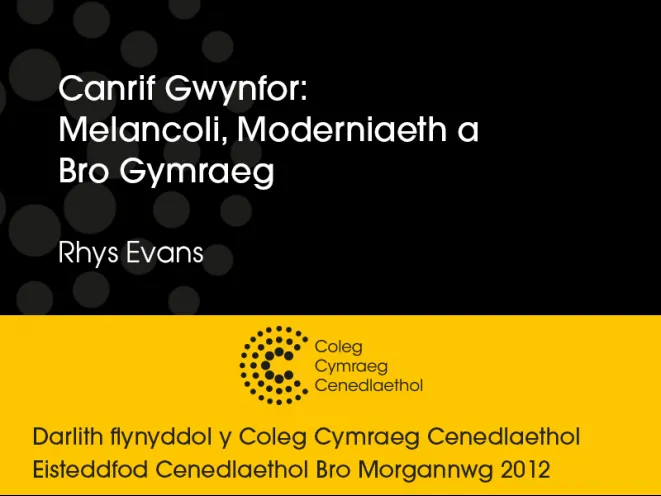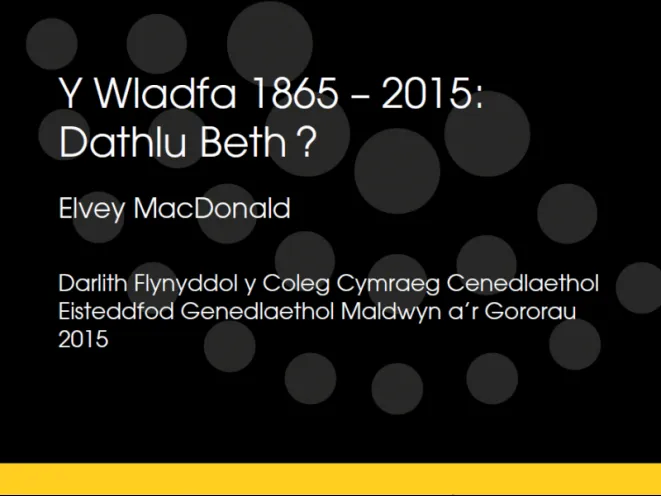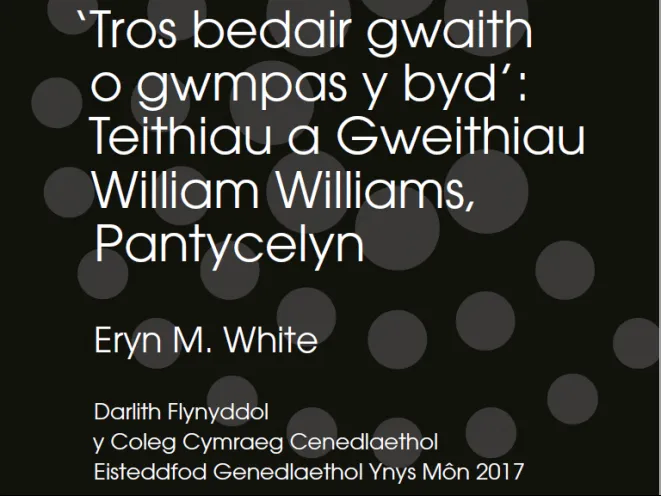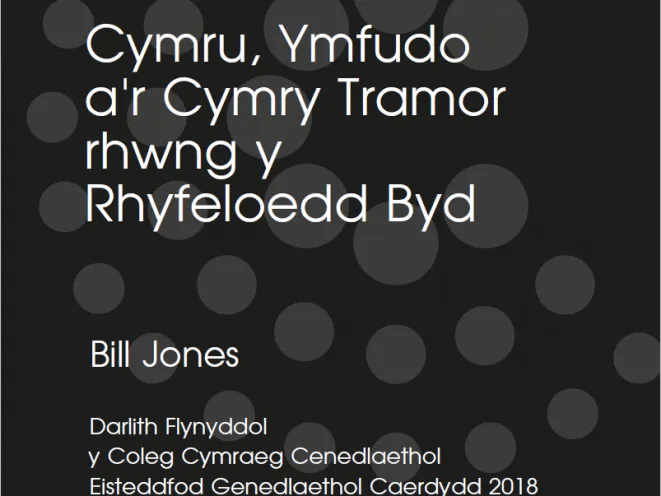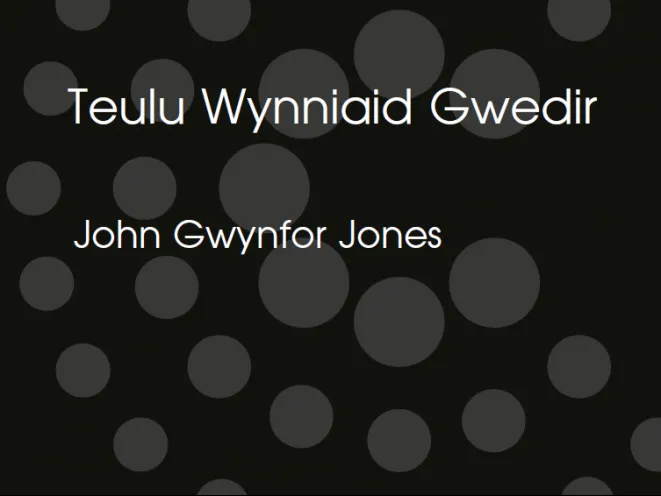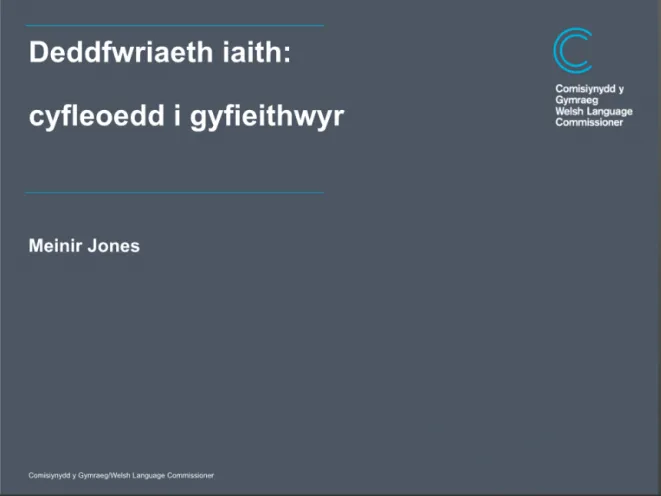Darlith Flynyddol y Coleg Cymraeg Cenedlaethol 2011: Seiliau Cyfansoddiadol y Ddeddfwrfa Gymraeg, gan yr Athro Richard Wyn Jones. Traddodwyd y ddarlith yn Eisteddfod Genedlaethol Wrecsam a'r Fro.
Darlith Flynyddol 2011: Seiliau Cyfansoddiadol y Ddeddfwrfa Gymreig
Darlith Flynyddol 2012: Canrif Gwynfor – Melancoli, Moderniaeth a Bro Gymraeg
Darlith Flynyddol y Coleg Cymraeg Cenedlaethol 2012: Canrif Gwynfor - Melancoli, Moderniaeth a Bro Gymraeg, gan Rhys Evans Traddodwyd y ddarlith yn Eisteddfod Genedlaethol Bro Morgannwg.
Darlith Flynyddol 2015: Y Wladfa 1865–2015 – Dathlu Beth?
Darlith Flynyddol y Coleg Cymraeg Cenedlaethol 2015: Y Wladfa 1865-2015 - Dathlu Beth? gan Elvey MacDonald. Traddodwyd y ddarlith yn Eisteddfod Genedlaethol Maldwyn a'r Gororau ar ddydd Mawrth 5 Awst 2015.
Darlith Flynyddol 2017: 'Tros bedair gwaith o gwmpas y byd': Teithiau a Gweithiau William Williams, Pantycelyn
Darlith Flynyddol y Coleg Cymraeg Cenedlaethol 2017: 'Tros bedair gwaith o gwmpas y byd': Teithiau a Gweithiau William Williams, Pantycelyn, gan Eryn White, Prifysgol Aberystwyth. Traddodwyd y ddarlith yn Eisteddfod Genedlaethol Môn ar ddydd Mawrth 8 Awst 2017.
Darlith Flynyddol 2018: Cymru, Ymfudo a'r Cymry Tramor Rhwng y Rhyfeloedd Byd
Darlith Flynyddol y Coleg Cymraeg Cenedlaethol 2018: Cymru, Ymfudo a'r Cymry Tramor Rhwng y Rhyfeloedd Byd, gan Bill Jones, Prifysgol Caerdydd.
Darlith Flynyddol 2019: Teulu Wynniaid Gwedir
Darlith Flynyddol y Coleg Cymraeg Cenedlaethol 2019: Teulu Wynniaid Gwedir, gan yr Athro John Gwynfor Jones.
The development of the syntax of numerals in Welsh
The rules determining the forms of nouns and adjectives after numerals and the associated initial-consonant mutations in Middle Welsh are often puzzling to Modern Welsh readers of the language. This article sketches the rules and provides a synchronic account of them. It is shown that they are based on a coherent system where number (singular, dual, numerative, plural) is central. The linguistic changes that have occurred since then are documented in detail and dated using textual evidence. It is argued that these changes can best be understood as steps along a pathway towards a new, equally coherent system where all numeral phrases are treated as singular, and gender rather than number determines both form and mutations.
Deddfwriaeth iaith: cyfleoedd i gyfieithwyr
Cyflwyniad pwerbwynt ar thema Deddfwriaeth iaith: cyfleoedd i gyfieithwyr a gyflwynwyd gan Meinir Jones o swyddfa Comisiynydd y Gymraeg, yn ystod Cynhadledd Heriau Cyfieithu Heddiw a gynhaliwyd ym Mhrifysgol Aberystwyth ar 27 Hydref 2017.
(Citizenship, the Welsh Language Board, and marketing the Welsh language)
This paper offers a brief examination of the approach taken by the Welsh Language Board, as the principal language policy and planning body in Wales, to aspects of prestige planning and the Welsh language. It describes how devolution, and the recent, first ever, national review by the Welsh Assembly Government of Welsh language policy, provide the immediate context for the work of the Welsh Language Board. The key policy document resulting from that review, Iaith Pawb, is critically analysed and the relationship to it of prestige planning is identified. The Welsh Language Board’s practice of prestige planning is discussed in relation to the discourses of neo-liberalism and post-colonialism in a way that highlights the Board’s focus on consumers rather than citizens.
Understanding performance deficiencies in printed thick film EL lamps on paper
In order to examine new potential markets for printed electronics, a research study was undertaken to understand the performance of opaque substrate electroluminescent (EL) lamps. Opaque EL lamps are made possible by a PEDOT:PSS top electrode which replaces the ITO used in the conventional lamps. Screen-printed lamps were manufactured on four substrates (one plastic and three paper) and their performance was measured through brightness measurement. Generally, opaque substrate lamps were 50% less bright than a comparable ITO lamp. Further reductions in brightness were observed with the lighter and rougher papers. Additional layers of PEDOT:PSS increased sheet conductivity but reduced lamp brightness due to a reduction in layer transparency. As lamp size increased, the resistive nature of the PEDOT:PSS caused a significant reduction in lamp output, with a brightness of 25% of a comparable ITO lamp with an illuminated area of 5000 mm2. The relatively poor performance of the opaque lamps is derived not only from the reduced conductivity and transparency of the PEDOT:PSS compared to ITO, but is also caused by the topological nature of the phosphor particles which result in some phosphor material lying outside the electric field created between the two electrodes.
Regional government and civil society in Wales and Catalonia
Strengthening and revitalising democracy was a common rationale for establishing regional goverment in Spain and the United Kingdom. In this context, this article aims to assess the impact of regional government on the relationship between civil society and devolved government in Wales and in Catalonia. Based on case studies, the extent to which regional government structures promote civil society participation is assessed and regional government’s impact on the identity of civil society is analysed. Despite the differences, in both cases regional goverments undertook ‘top-down’ efforts to build civil society and the latter has contributed to the Catalan and Welsh nation-building projects. The findings draw attention to the potentially negative democratic implications arising from regional government and civil society relations and the effects of broader political culture.
(The nature of language acquisition processes in children: Marking grammatical gender in Welsh)
Research on the acquisition of grammatical gender has shown that in many languages children gain an early command of gender. Often in these languages gender marking is quite overt and provides a clear one-to-one correspondence between a marker and the gender encoded. In Welsh, however, gender marking is more complex. It is marked by mutations, a set of morpho-phonological changes that affect the initial consonants of words, and the mapping between mutation and gender is quite opaque. Two mutation types are used to mark feminine gender: both feminine nouns modified by the definite article and adjectives following feminine nouns undergo soft mutation, and the feminine gender of the possessive adjective ‘ei’ is marked by aspirate mutation of the modified noun. This paper presents two studies that examine children’s and adults’ productive command of gender as expressed in the mutation of nouns modified by the definite article, and adjectives modifying nouns. Children, between the ages of 4½ and 9 years old, and adults were invited to take part in the studies. First, a semi-naturalistic study was conducted to obtain knowledge about speakers’ usage of gender marking. A Cloze procedure was then used to elicit speakers’ production of masculine and feminine forms, with both real words and nonsense forms, in a variety of linguistic contexts. Some of these contexts provided cues to gender status, some did not. The data obtained indicated that the acquisition of the Welsh gender system is a long drawn-out process, and children have not mastered the system even by 9 years of age. Welsh speakers, even in adulthood, pay little or no attention to the possible cues present in the input. Results suggest that when a language has a complex gender system that is marked by opaque morpho-phonological processes the course of development is protracted and variable.

